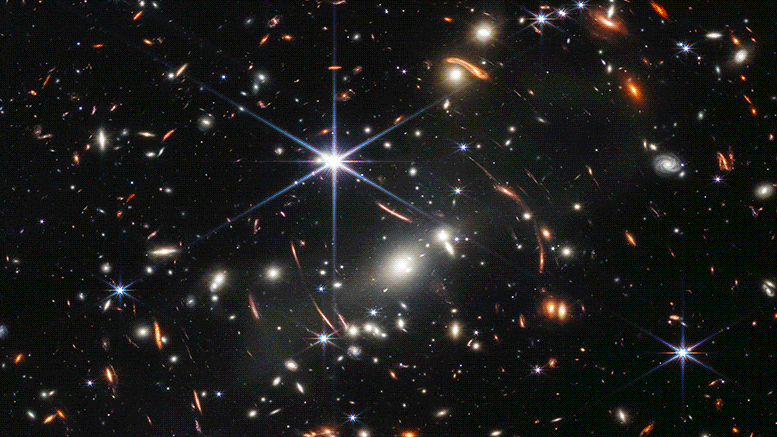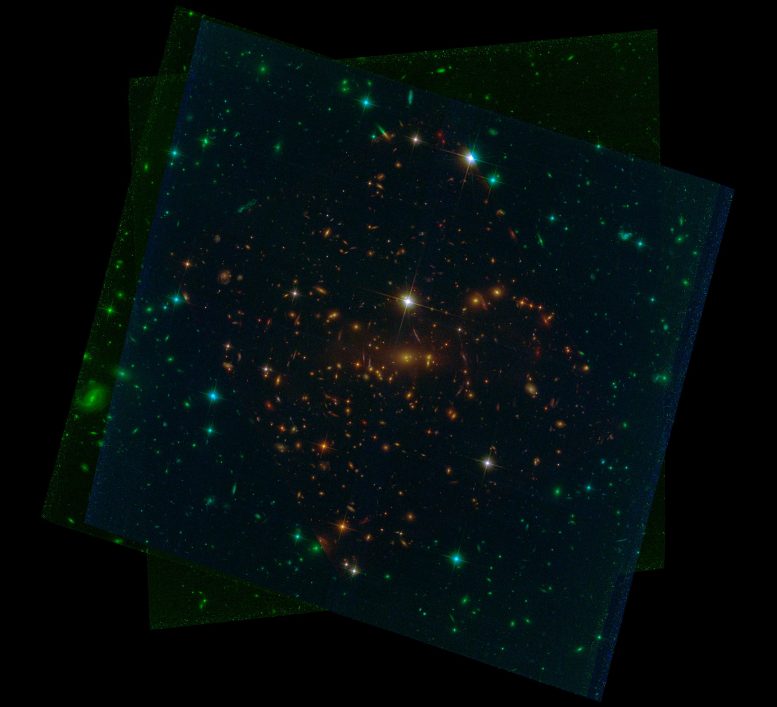
On Monday, July 11, President Joe Biden released one of the James Webb Space Telescope’s first images in a preview event at the White House in Washington. NASA, in partnership with ESA (European Space Agency) and CSA (Canadian Space Agency), will release the full set of Webb’s first full-color images and spectroscopic data during a televised broadcast beginning at 10:30 a.m. EDT (7:30 a.m. PDT / 14:30 UTC) on Tuesday, July 12, from NASA’s Goddard Space Flight Center in Greenbelt, Maryland.
This first image from NASA’s James Webb Space Telescope is the deepest and sharpest infrared image of the distant universe to date. Known as Webb’s First Deep Field, this image of galaxy cluster SMACS 0723 is overflowing with detail. Thousands of galaxies – including the faintest objects ever observed in the infrared – have appeared in Webb’s view for the first time. This slice of the vast universe covers a patch of sky approximately the size of a grain of sand held at arm’s length by someone on the ground.

- President Joe Biden unveiled this image of galaxy cluster SMACS 0723, known as Webb’s First Deep Field, during a White House event on Monday, July 11
- Webb’s image covers a patch of sky approximately the size of a grain of sand held at arm’s length by someone on the ground – and reveals thousands of galaxies in a tiny sliver of the vast universe
- Webb’s sharp near-infrared view brought out faint structures in extremely distant galaxies, offering the most detailed view of the early universe to date
- NASA and its partners will release the full series of Webb’s first full-color images and data, known as spectra, Tuesday, July 12, during a live NASA TV broadcast
U.S. President Joe Biden and NASA Administrator Bill Nelson preview the first full-color image from NASA’s James Webb Space Telescope, the highest-resolution image of the infrared universe in history in the South Court Auditorium in the Eisenhower Executive Office Building on the White House complex in Washington. Credit: White House
NASA’s James Webb Space Telescope has produced the deepest and sharpest infrared image of the distant universe to date. Known as Webb’s First Deep Field, this image of galaxy cluster SMACS 0723 is overflowing with detail.
Thousands of galaxies – including the faintest objects ever observed in the infrared – have appeared in Webb’s view for the first time. This slice of the vast universe covers a patch of sky approximately the size of a grain of sand held at arm’s length by someone on the ground.
This deep field, taken by Webb’s Near-Infrared Camera (NIRCam), is a composite made from images at different wavelengths, totaling 12.5 hours – achieving depths at infrared wavelengths beyond the Hubble Space Telescope’s deepest fields, which took weeks.

The image shows the galaxy cluster SMACS 0723 as it appeared 4.6 billion years ago. The combined mass of this galaxy cluster acts as a gravitational lens, magnifying much more distant galaxies behind it. Webb’s NIRCam has brought those distant galaxies into sharp focus – they have tiny, faint structures that have never been seen before, including star clusters and diffuse features. Researchers will soon begin to learn more about the galaxies’ masses, ages, histories, and compositions, as Webb seeks the earliest galaxies in the universe.
This image is among the telescope’s first-full color images. The full suite will be released Tuesday, July 12, beginning at 10:30 a.m. EDT (7:30 a.m. PDT), during a live NASA TV broadcast. Learn more about how to watch.
The James Webb Space Telescope is the world’s premier space science observatory. It will solve mysteries in our solar system, look beyond to distant worlds around other stars, and probe the mysterious structures and origins of our universe and our place in it. Webb is an international program led by NASA with its partners, ESA (European Space Agency) and CSA (Canadian Space Agency).
NASA Headquarters oversees the mission for the agency’s Science Mission Directorate. NASA’s Goddard Space Flight Center in Greenbelt, Maryland, manages Webb for the agency and oversees work on the mission performed by the Space Telescope Science Institute, Northrop Grumman, and other mission partners. In addition to Goddard, several NASA centers contributed to the project, including the agency’s Johnson Space Center in Houston; Jet Propulsion Laboratory (JPL) in Southern California; Marshall Space Flight Center in Huntsville, Alabama; Ames Research Center in California’s Silicon Valley; and others.
Never miss a breakthrough: Join the SciTechDaily newsletter.
6 Comments
You know what? I know it took a few extra years to get Webb to the Lagrange 2 spot, but God … It was well worth the wait!!! Who agrees with me? These images are a awesome!
Science and knowledge are beautiful….in the end it will prevail over everything else.
What has Biden got to do with anything here??
President in name only and probably understands nothing of the science. The announcement is a public relations opportunity that he does not deserve. He has had nothing to do with the trials and tribulations of getting Webb built and launched.
Science needs to stay out of politics. This is a really bad slope.
I think that you have it backwards. Politics needs to stay out of science. Politicians need to provide the resources necessary for projects like this, and then stand back and get out of the way of those who have made it happen.